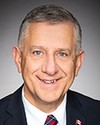I can imagine you do. I have no idea what you pay them and I don't want to know. But when I look at the Auditor General's report he talks about supporting mechanisms that support the scope, working outside the scope.
Personally, my wife's a nurse. She's licensed in the province of Ontario. If she works outside her scope, she will lose her licence if she gets caught. I can imagine nurses get nervous when they're asked to work outside their scope, not necessarily by the department but by a patient in a remote region who can't get service. Looking at someone who's critically ill or injured and doing what they need to do to serve the patient at the time is outside their scope. What a dilemma they're placed in, Ms. Buckland. You're a registered nurse with a licence. You know exactly what that means to them. I can imagine the stress they go through with that.
Then we hear about a residence that doesn't have a septic system for two years. I live in the country. I had three kids who used to live in my house. I can imagine that septic system being down for two days, never mind two years, and there being a riot. Can you imagine living in those conditions, Mr. Perron? Do you wonder why you have retention issues?
By working outside the scope as a professional you can lose your licence. You're asking them to do that. You're placing them in a position to have to do that. Having them reside in a place that isn't fit for human health.
Then the Auditor General goes through a litany of other things like ventilation and cooling systems that don't work. Working in an environment where the X-ray door may not seal properly and you're asking them to give X-rays to people. And you wonder why you have retention issues? It's lucky you have any.
It's amazing you don't have nine out of ten leave, never mind five out of ten. Who would work in those kinds of conditions? You would have strikes across southern Ontario and every major manufacturer if this is how they treated their employees and these sorts of things weren't addressed.
That's why you have retention issues. It isn't about how much you pay. It's about asking them to work outside the scope of their professional ability to do so and that their licence could be revoked. You place them in a place where it's unfit to live. You don't train them properly before they go. And then you say you have retention issues.
Yes, you have retention issues. You have major problems. You have 11 recommendations of which two go back to 2010, five years ago, that you promised to complete, that you didn't get completed. You said then that you had a retention issue. You still have a retention issue.
Quite frankly, your department, sir, has failed. You've failed this Parliament, because your obligation is to us, but more importantly you've failed first nations people. That's who you've really failed.
This wouldn't happen in Welland, let me tell you. Never would we put up with this service in Welland. It wouldn't happen. There would be a riot in the street if we thought this was the kind of service we were going to get. Nurses would not go to work in the places that you're asking them to go to work in if it were in southern Ontario. It wouldn't happen. That's why you have retention issues.
You have a lot of work to do, sir, and you need to start soon. In fact you needed to start five years ago and you didn't get started then. Quite frankly, I have no idea how you're going to make this up and how quickly you're going to make it up, but you need to make it up in a hurry. I don't know what resources you need, whether it be people or money, but if you intend to have a service that's equivalent or reasonably equivalent to what our expectations are, including your department's expectations.... Could you put them in writing?
I don't know when you intend to get started, but my goodness, you needed to get started a long time ago. The people of this country, our first nations people, deserve better, and we've failed. Hopefully, sir, when the next report from the Auditor General comes we won't be seeing the same thing, because quite frankly, to be truthful, in any other major industry or other place, heads would roll. My friend across the way and I worked in the auto sector. If this were an indictment of our sector, heads would roll for that kind of performance.





